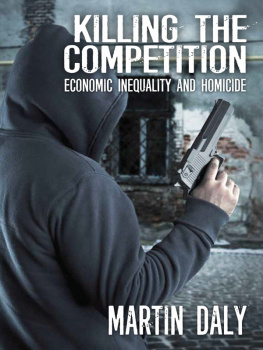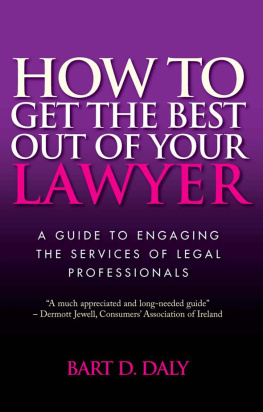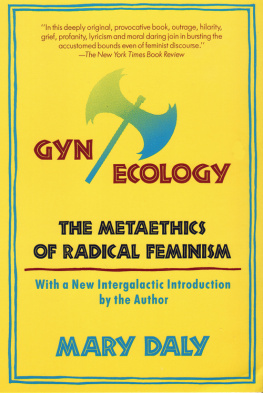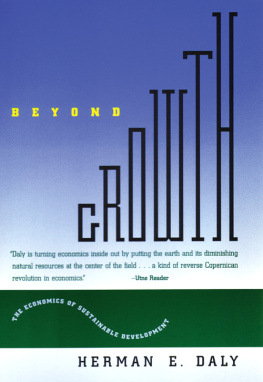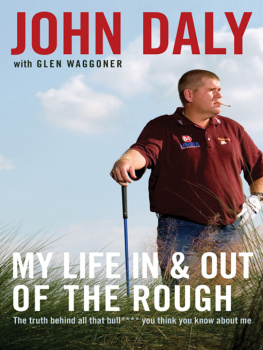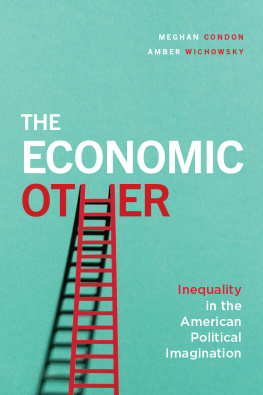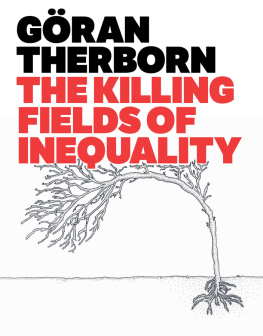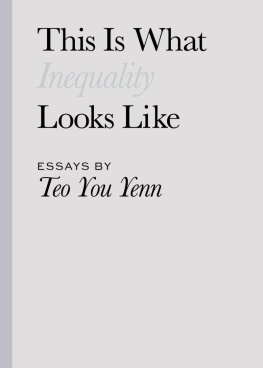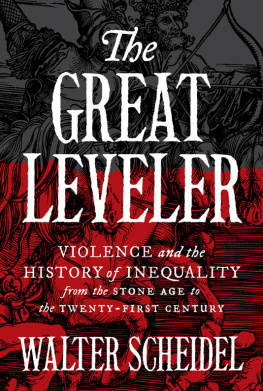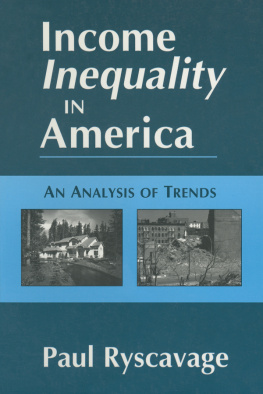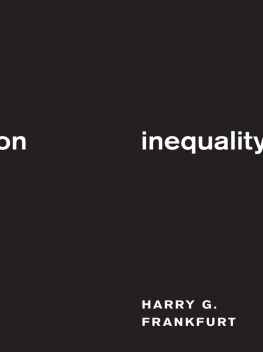
Copyright 2016 by Transaction Publishers, New Brunswick, New Jersey.
All rights reserved under International and Pan-American Copyright Conventions. No part of this book may be reproduced or transmitted in any form or by any means, electronic or mechanical, including photocopy, recording, or any information storage and retrieval system, without prior permission in writing from the publisher. All inquiries should be addressed to Transaction Publishers, 10 Corporate Place South, Suite 102, Piscataway, New Jersey 08854. www.transactionpub.com.
This book is printed on acid-free paper that meets the American National Standard for Permanence of Paper for Printed Library Materials.
Library of Congress Catalog Number: 2016017681
ISBN: 978-1-4128-6325-4 (hardcover); 978-1-4128-6336-0 (paper)
eBook: 978-1-4128-6357-5
Printed in the United States of America
Library of Congress Cataloging-in-Publication Data
Names: Daly, Martin, 1944- author.
Title: Killing the competition : economic inequality and homicide / Martin Daly.
Description: New Brunswick : Transaction Publishers, [2016] | Includes bibliographical references and index.
Identifiers: LCCN 2016017681 (print) | LCCN 2016022608 (ebook) | ISBN 9781412863254 (hardcover) | ISBN 9781412863360 (pbk.) | ISBN 9781412863575 (eBook)
Subjects: LCSH: Homicide--Economic aspects. | Income distribution--Social aspects. | Crime--Sociological aspects.
Classification: LCC HV6515 .D353 2016 (print) | LCC HV6515 (ebook) | DDC 364.2/5--dc23
LC record available at https://lccn.loc.gov/2016017681
Contents
Income inequality is a correlate of homicidal violence, and I believe that the evidence strongly favors the hypothesis that the relationship is causal. Not everyone agrees with me on this point, however, and my primary agenda in this book is to refute the counterarguments. I think we have sufficient evidence that the inequality of wealth and income that now prevails in the developed world has toxic effects, including effects on violence, to justify political action to reduce it.
I have been studying homicide for more than thirty-five years, but I began my research career in animal behavior, and the Darwinian world view that I acquired studying other species continues to inform my understanding of all living things, including human beings. Any evolutionist would anticipate that whenever desired goods are distributed relatively inequitably, dangerous competition and violence will be relatively prevalent. Analysts whose thinking is not informed by Darwinism, however, often miss this point and misinterpret self-interested aggression as pathology. Two secondary aims of this book are thus to introduce an evolution-minded perspective into discussions of human violence, and to counter the simplistic notion that because violence is distasteful, it must be pathological.
Many people have contributed to the writing of this book, above all my late wife Margo Wilson, who decided in 1978 that we should study homicide; all my research on the subject was done in collaboration with her until her death in 2009. Margo and I probably would have abandoned homicide research were it not for substantial early support from the Harry Frank Guggenheim Foundation and its high-spirited research directors Lionel Tiger and Robin Fox. Subsequently, our research was supported for many years by the Natural Sciences & Engineering Research Council of Canada and by the Social Sciences & Humanities Research Council of Canada.
Despite our strange backgrounds in animal behavior, many sociologically trained homicide researchers welcomed us into their community, especially Becky and Dick Block, and Russell and Rebecca Dobash. My education in economics began when Rob Boyd and Herb Gintis invited Margo and me to join the Preferences Network, sponsored by the John D. and Catherine T. MacArthur Foundation, at whose meetings we learned a great deal about how economists approach risk and sex differences, especially from Catherine Eckel, and a great deal about economic inequality, especially from Sam Bowles.
This book was written mainly during a three-year stint in 201215 as a Research Professor of Anthropology at the University of Missouri, Columbia, which was made possible primarily by Mark Flinn and Brian Foster. My education in anthropology began when Margo and I spent a sabbatical year at Harvard University in 198586 under Irven DeVores generous sponsorship, and was furthered during another sabbatical year at the University of New Mexico in 199495, where Jane Lancaster was an equally generous host. My primary academic affiliation is still in psychology, and I am now back in the Department of Psychology, Neuroscience & Behaviour at McMaster University, which has been my main home since 1978, and which is far and away the most collegial university department that I have ever seen.
Four people deserve special thanks for providing a steady stream of useful links and references, encouragement and critical discussion, while I was writing this book. They are Danny Krupp, Karthik Panchanathan, Gretchen Perry, and Adam Sparks. I have also benefited from collegial input from Pat Barclay, Sam Bowles, Napoleon Chagnon, Dov Cohen, Helena Cronin, Maurice Cusson, Angus Deaton, Robin Dunbar, John Fox, Willem Frankenhuis, Daniel Hicks, Joan Hamory Hicks, Sarah Hrdy, Arjun Jayadev, Ichiro Kawachi, Bruce Kennedy, Rob Lynch, Michelle Mahnke, Sandeep Mishra, Paulo Nadanovsky, Richard Nisbett, Michael Norton, Marc Ouimet, Josephine Pemberton, Kate Pickett, Steven Pinker, Aubrey Sheiham, Mary Shenk, Seth Stahlheber, Shawn Vasdev, and Richard Wilkinson.
Finally, I could not have written this book without the unflagging support of my wonderful wife Gretchen Perry.
Martin Daly
Hamilton, Ontario, Canada
September, 2015
Crimes as serious as murder should have strong emotions behind them.
George Orwell, Decline of the English Murder, 1946
Inequality, Competition, and Homicide
Homicides are intensely interesting. When theres a murder, anyone who has even a remote connection to the case craves details. People want to know exactly what happened, and why. This morbid fascination is healthy and normal. The natural habitat of the human mind is a social universe of personal acquaintances, gossip, and hearsay. In such a social universe, it has always been important to gather all the information you can about who is dangerous, and in what situations. Lethality is a big deal.
As fascinating as the stories behind individual murder cases may be, homicides become even more interesting when we study their statistical properties dispassionately. When they are appropriately aggregated and summarized, the statistics of homicide provide us with a sort of window on human passions. What are the sources of interpersonal conflict that can induce someone to kill? The most important is apparently inequality: the degree to which the things that men desire are equitably or inequitably distributed.
Decades of research have shown that if you want to predict the homicide rate of a nation, or a state, or a city, the best single piece of information to help you make that prediction is the level of income inequality. Unfortunately, the criminologists who have confirmed this result again and again remain befuddled about what to make of it. One reason for their befuddlement is that, like many other social scientists, most criminologists believe that violence itself is a form of pathology. This is a mistake. Although some killers are indeed insane, violence itself is an organized, evolved capability of normal human beings, pursuing their interests in a world in which peoples interests conflict. The misunderstanding of violence as pathology has blinded analysts to a simple, intuitively appealing interpretation of the facts before them. A local homicide rate is a manifestation of the local level of competition for scarce resources, and economic inequality is a major determinant of the severity of that competition. One of my aims in this book is to lay out the case that this straightforward interpretation is correct.

